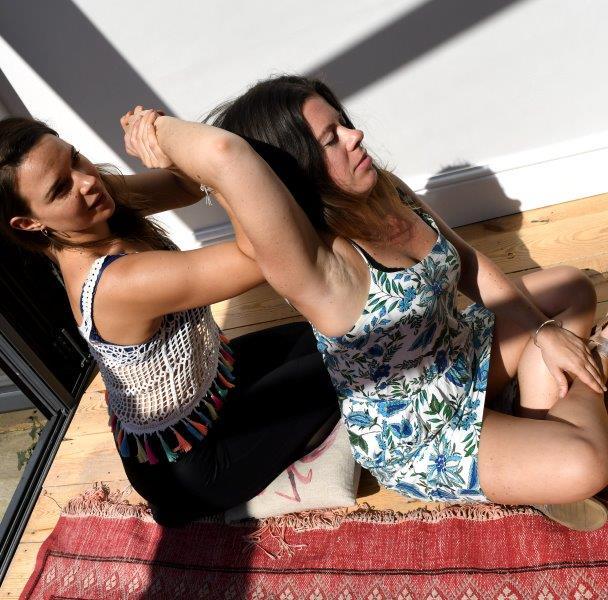Yoga and Thai Massage: A Match Made in Heaven
Don’t be fooled by the ‘Thai’ part of the Yoga Massage…in actual fact, both disciplines of Yoga and Thai Massage are rooted in the Vedas; the ancient hymns composed and recited in Punjab (Northern India) as early as 1500 B.C.
Daria Germondari, practitioner, teacher and therapist of both disciplines highlights the complementary nature of these magical practices.

When practiced and experienced together, Yoga and Thai Massage can have a truly transformational effect on us and our practice.
Long before today’s fancy yoga poses, India’s Rishis (or hermits) renounced worldly life in search of a spiritual discipline deep-seated in pranayama, prayer, chanting, ritual, ceremony, mindfulness and meditation. This is the very basis of Thai Yoga Massage, with its physical application of the Buddhist Metta Bhavana meditation, or Loving Kindness. The start of a Thai Yoga Massage is marked with the intention to channel loving kindness to the receiver. Think of it like Reiki where the therapist acts as a vessel to channel positive energy to your physical and energetic body, therefore supporting, facilitating and fostering an energetic shift normally in the form of freeing the flow of blocked energy. Similar to a Yoga class, you will be invited to let go, surrender and simple Be, in order for healing to take place.
As with Yoga, a Thai Massage focuses on clearing energetic pathways to re-balance the individual. This is achieved by skilfully pummelling, thumbing, pressing, stretching and massaging the Sen lines; the invisible energy points (similar to the Nadis of Yoga). In Yin Yoga, we work with certain Meridians that correspond to different organs in the body. In other types of Yoga, we focus on the 7 Chakras that are interlinked with the 72,000 Nadis that “wire” the energetic body. Similarly, in Thai Massage, we focus on 10 of these energy pathways called Sip Sen or ten Sen. Whether we are talking about Sen, Meridians, Nadis, or Chakras, the foundation for both practices lies in the belief that there is a wider life force, or Prana, that circulates through these invisible channels of energy.
The “master” channel in Yoga is known as the Sushumna Nadi that runs along the energetic spine. It is of no surprise therefore that in Thai Massage this channel is known as Sen Sumana. What is surprising however, is the lack of historical evidence around the direct relationship between these sister practices and how Thai Massage came to be established in Thailand. There are countless scriptures and manuscripts on the history of the Yogic tradition, yet when it comes to Thai Massage the history is a little murkier. It is assumed that Thai Massage came to Thailand along with Buddhism in the second or third century B.C. but the little evidence of this perished in 1767 when Burmese invaders attacked Thailand.
Some evidence of the similarities between the two traditions lies in a practice called Reusi Dat Ton that seems to bridge the gap between Yoga and Thai Massage with self-adjustments and self-massage. Reusi is the Thai word for the Indian Rishi, meaning Hermit. The full transliteration is “Hermit Self-Stretching” which explains the exact nature of the practice that was prescribed by Thai physicians to their patients. It is thought to be the foundation of Thai Massage and therefore can be viewed as the agent that binds and marries Yoga with Thai Yoga Massage. In terms of the suspected founder of Thai Massage, scriptures suggest that Indian-born Jivaka Kumar Bhaccha, also known as the “Father of Medicine” and close friend of The Buddha himself, was himself a Rishi or Reusi (Hermit) who brought together Yoga, Reusi Dat Ton and Thai Massage or Nuad Thai as it is also known.
When looking at the physical element of the practices, i.e. postures or asana, there are many yoga poses that appear throughout Thai Massage. For example I often work with supine or seated twists, Child’s Pose and Cobra to name a few. Thai Massage also follows the Yoga basis that each pose will need a counter pose. So an assisted Cobra will often be followed by a forward fold in order to bring balance to the body.
I have often witnessed holistic healers “prescribe” both Yoga and Thai Massage to their clients in order to achieve the best results. This is because with massage, you can go beyond the limitations of your own practice. Think how great it feels to be adjusted in class – with the breath going deeper and the body opening further – now imagine that for the duration of the whole massage! For a massage therapist, learning the skills of Thai Massage allows you to bring excellent assists and adjusts into your classes, as I have found to be the case. Another reason these two practices really are a match made in heaven!
Curious to experience it for yourself and see how Thai Massage can complement your yoga practice?
Then you can find Daria on Monday evenings at the Life Centre, Islington.
